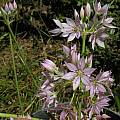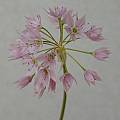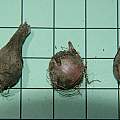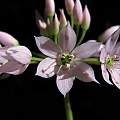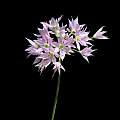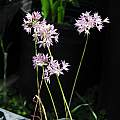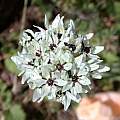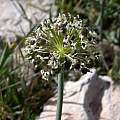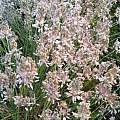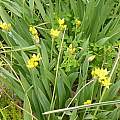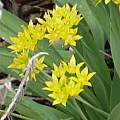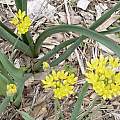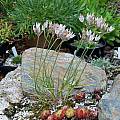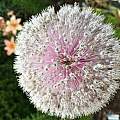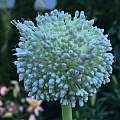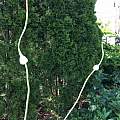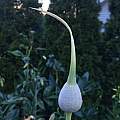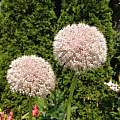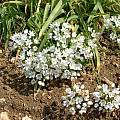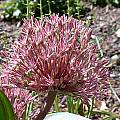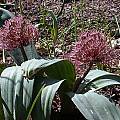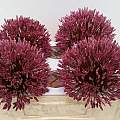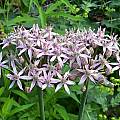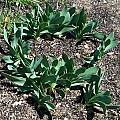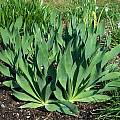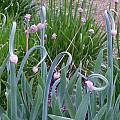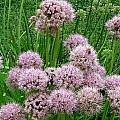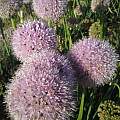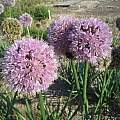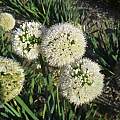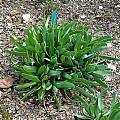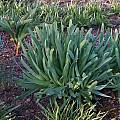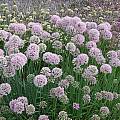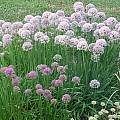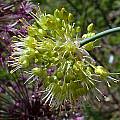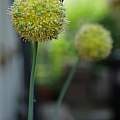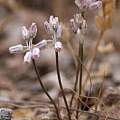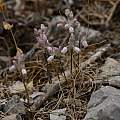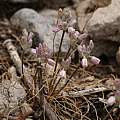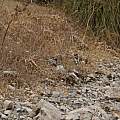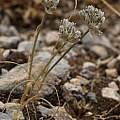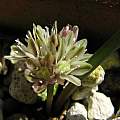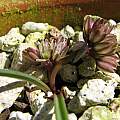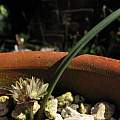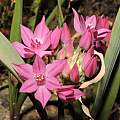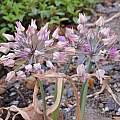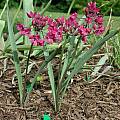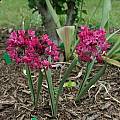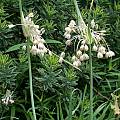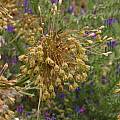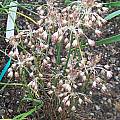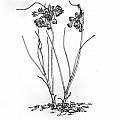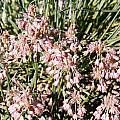This page compiles all the information and photos of the Allium taxa, cultivars, and hybrids we currently have on the PBS wiki. The Allium index gives information about the genus and includes tables of species and hybrids and cultivars.
Page 1: A. Globemaster... Page 2: A. atropurpureum... Page 3: A. carmeli... Page 4: A. decipiens... Page 5: A. guttatum... Page 6: A. karataviense... Page 8: A. paradoxum... Page 9: A. regelii... Page 10: A. serra... Page 11: A. tardiflorum... Page 12: A. vineale...
Allium membranaceum Ownbey ex Traub grows in Northern California from 500 to 4500 ft (150 to 1350 m) and is most similar to Allium campanulatum S.Watson than to any other species. It has white to pale pink flowers on an erect stem, flat leaves, and a very dainty appearance. Photos 1-3 were taken by Mary Sue Ittner. Photo 3 shows the bulbs on a 1 cm grid. Photos 3-6 were taken by Nhu Nguyen of the same clone.
Allium meronense Fragman & R.M. Fritsch is native to Israel and Lebanon. Bulbs are egg-shaped, up to 30 mm long. Scape is flexuous or ascendant, up to 25 cm long. Leaves are narrowly lanceolate, up to 30 cm long. Tepals are white with faint green midveins; anthers yellow; ovary deep purple. The species was first described in New Species of Allium Sect. Melanocrommyum from the Eastern Mediterranean authored by Ori Fragman-Sapir and Reinhard M. Fritsch. Photos by Gideon Pisanty. First photo shows flowers, second photo shows ripening seed pods.
Allium meteoricum Heldr. & Hausskn. ex Halácsy is native to Albania, Greece (mainland) and Former Yugoslavia, though it's distribution is uncertain. This tiny species makes a 1-3 cm ball of flowers on a 15 cm stem in summer. The flowers are light pink cylinders with contrasting yellow anthers. It grows on dry rocky slopes, and likes well drained conditions in the garden. Photo by Wietse Mellema of a large mass of the bulbs in his bulb farm in the Netherlands.
Allium moly L. is an attractive species from southern Europe. It is unusual among alliums in having bright yellow flowers. It is readily available in the US via the Dutch bulb trade as the form "Jeannine" which is purported to have larger umbels and flower earlier than the species. It grows best in well drained soils in a sunny location. Normally two leaves emerge from each bulb and one to two umbels of bright yellow flowers are produced in late May after which time the foliage begins to die back. It is self fertile and produces numerous black seeds which can self sow. Bulbs divide as well. Photographs by Ernie DeMarie.
Allium moschatum L. - I'm particularly fond of this tiny delicate species, from European/Mediterranean regions. While its appearance is demure, I assure you the plant is tough, hardy, and long-lived. Excellent in a trough where its small proportions can be appreciated, it flowers in July-August atop wiry 4-5" (10-12.5 cm) stems. The foliage is extremely short, firm, wiry, and basal. The flowers are white, with reddish veining. Photo by Mark McDonough.
Allium myrianthum Boiss., described by Pierre Edmond Boissier in 1844, this species comes from Turkey, Egypt and Syria. Photos by Rimmer de Vries who comments: ex Ruksans collection Turkey (N. of Anatayla)- growing to 5 feet tall with 4 inch globes of millions of very tiny whitish to pale mauve flowers with pinkish floret pedicels.
Allium neapolitanum Cirillo is a very common species in the south of Italy and a true weed in my yard. Photo in habitat by Angelo Porcelli.
Allium nevskianum Vved. ex Wendelbo is from Afghanistan, Uzbekistan, and Tajikistan where it grows in dry mountains at high elevations. It is a superb dwarf species but with immense balls of bloom, somewhat like an enlarged Allium karataviense Regel, but with deeper colored blooms. The first two photos by John Lonsdale. The last two photos by Wietse Mellema from his bulb farm in the Netherlands.
Allium nigrum L. is native to southern Europe, Asia and North Africa. Pictured below is a "pink form" (syn. Allium auctum Omelczuk) - Grown from seed, requiring 4-5 years to bloom from seed, this is one of the prettiest forms of the European melanocrommyum A. nigrum that I've grown. Very slow to increase but worth the wait. Photo by Mark McDonough.
Allium nutans L. is a Siberian species that is highly variable with both superior and inferior forms. The one shown here is remarkable on account of the extra wide and thick gray leaves that spirally twist into impressive mounds. The first photo shows the plant in spring with the pirouetting rosettes of foliage, the second shows the massive muscular leaf rosettes in June, the third shows the nodding and twisting flower stems, and the last shows the typical flower form, dense floral globes that look fuzzy on account of the protruding stamens. Flower color can be found in all shades of rose, lilac, pink, to white. It is also one of the parents of Allium 'Sugar Melt'. Photos by Mark McDonough.
Several named selections are also available. Following are a few grown and photographed by Wietse Mellema, a bulb farmer from the Netherlands. The first is Allium nutans 'Caroline', a silver medal winning selection from the hands of P. de Jong. Early in the spring to develop the twisted light gray, 30 cm long leaves that remain into autumn. The flower buds have a nodding head, but in late June they turn up and open to lilac pink flowers. The second is Allium nutans 'Esmee' with flowers that are slightly larger and darker than those of 'Caroline' and leaves not twisted. The third is Allium nutans 'Isabelle', a white flowered form, sometimes blushing pink. Smaller in all respects to 'Caroline'.
"selected hybrid, finger-leaf, large pale flower globes" - Here's a hybrid that has finger-like leaves that build up into attractive mounds, and a prolific display of large pale lavender globes in August. The are four photos in a progression of growth. Photos by Mark McDonough.
Allium obliquum L. is native to Central Asia where it grows in meadows, scrub and on cliffs. It has soft yellow flowers that appear in summer. They last rather longer than most ball Alliums by sequentially opening new single flowers. Photos by John Lonsdale and Martin Bohnet.
Allium obtusiflorum DC. (syn. Allium maritimum Raf., Allium pusillum Cirillo ex Ten.) is endemic to Sicily, Italy, in the northern coast near Palermo. It grows in maritime sands, and on cliffs and hillsides. Allium erythraeum Griseb. and Allium thessalicum Brullo & al. were once considered synonymous with A. obtusiflorum, but were discovered to be separate species in the paper Cytotaxonomical revision or the Allium ohtusiflorum group (Alliaceae) by Salvatore Brullo et al 1994. There is not agreement about the name for this species. IPNI lists it as Allium obtusiflorum Redouté (published in 1805) and does not have a listing for Allium obtusiflorum DC. although that name is found in Tropicos. Plants of the World Online lists it as Allium paniculatum subsp. obtusiflorum (Redouté) Brand, a synonym of Allium obtusiflorum Redouté. Photos by Davide Pacifico in Italy.
Allium obtusum Lemmon is native to the Foothills and High Sierra Nevada and north to the Cascade Range of California and just a little bit of Nevada. It is a tiny species. The photos below were taken by Nhu Nguyen of plants growing in a 4" terracotta pot. Notice the pumice particles for scale.
Allium oreophilum C.A.Mey. is an easy to grow species from Central Asia. The small plants reach a height of less than 8" with small pink flowers. The filaments are flattened and tapered to the anthers. Photo 1 by Travis Owen taken May 2015 in Rogue River, OR. Photo 2 shows drying capsules.
Allium oreophilum 'Torch' is a superior form of the commonly available A. oreophilum. This cultivar and one other named 'Agalik' are rather expensive and only available from specialty bulb nurseries. Two photos by Mark McDonough, one at early anthesis in June, and the latter one taken in early July. The flowers heads are full and the large florets are intense carmine in color, really showing up well in the garden.
Allium paniculatum L. The ubiquitous Allium paniculatum is found throughout Europe, North Africa, Asia, including China. Several subspecies are named, and in all of them, the diversity of forms is rather pronounced. The first photo by Mark McDonough shows a "tall white and brown form" is a nice attractive form growing up to 2' tall (60 cm) with a higher bud count than many paniculatum forms, spilling over with nodding bowl-shaped florets of white, subtlety stained pale olive-tan. The second photo is by Nhu Nguyen taken at the UC Botanical Garden where it has escaped and can be found on dry hillsides. In mediterranean climates, this species blooms in spring, goes dormant in late summer and grows leaves throughout winter.
"Dwarf reddish form" - This species occurs in a wide variety of colors. The one shown here is a common theme; basically having white flowers flushed and edged with brownish red. Growing only about 4"-6" (10-15 cm), it is well suited to the sunny rock garden in sandy soil. Photo and drawing by Mark McDonough.
Allium paniculatum ssp. fuscum (Waldst. & Kit.)Arang., (a synonym of Allium fuscum Waldst. & Kit.) 'Jerry' - Of the dwarf reddish flowered forms of Allium paniculatum I liked this form the best, given to me by Jerry Flintoff. The white flowers are so generously tinged red that the mass of little flower sprays appears a pale flesh color when in bloom in July. Photo by Mark McDonough.
Page 1: A. Globemaster... Page 2: A. atropurpureum... Page 3: A. carmeli... Page 4: A. decipiens... Page 5: A. guttatum... Page 6: A. karataviense... Page 8: A. paradoxum... Page 9: A. regelii... Page 10: A. serra... Page 11: A. tardiflorum... Page 12: A. vineale...
Allium index - Allium flavum Relatives - American alliums A-F - American alliums G-Z - Big Ball alliums - Blue alliums - Chives - Domed alliums - Drumstick alliums - Rhizomatous alliums
